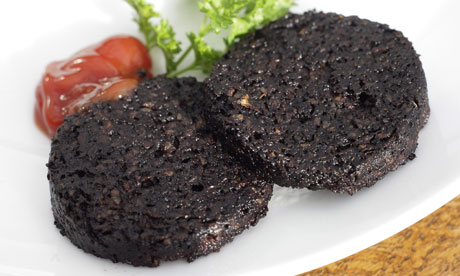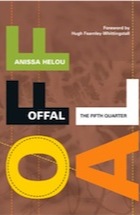
Stornoway black pudding. Photograph: Tina Norris/Rex Features
Blood
"This is a dish (blood soup) that 6-8 years old girls make themselves but which young boys also prize highly. When it is ready, some of the soup is poured into a flat dish and the boys lie on their stomachs round this and eat like dogs, while the small girls eat with their hands from the pot."
• Sverdrup on the children of Reindeer Chukchi, 1901
• Sverdrup on the children of Reindeer Chukchi, 1901
The mention of blood as food immediately conjures up images of blood-sucking vampires biting into the necks of nubile virgins. However, you don't need to
be a vampire, real or imagined, to like animal blood.
be a vampire, real or imagined, to like animal blood.
Most cultures eat blood in one form or another and blood puddings (boudin) are made all over Europe. The filling for boudin is basically pig's blood and fat, although the Irish use sheep's blood for drisheen (their version of boudin). In France, they may add onions, chestnuts or small cubes of cooked head meats. In Spain they add rice and in Scotland oats. Whatever the mixture, it is seasoned with spices and herbs, funnelled into intestines and cooked very gently in a broth. In Iceland, where the women make a lot of blood sausages during the slaughtering season in the autumn, the sausages are pickled in whey-barrels.
Boudin is not the only edible blood product. In Spain, congealed blood is sold in blocks for people to use in different ways. The most common use is for it to be diced and sautéed with onions to serve as a tapa (encebollada in sangre). In Thailand, people add cubes of congealed blood to fish tripe soup. In France, they have Sanguette, a speciality from the Languedoc which was very common when chickens were killed at home. It is still prepared in some rural areas. The chicken is bled over a deep plate. Then the blood is seasoned with crushed garlic, chopped parsley and sometimes sautéed cubes of lean bacon and left to congeal before being fried in a little lard. The pan is deglazed with a little vinegar and the resulting sauce poured over the sanguette.
A very different version of sanguette is made in the Béarn. The Béarnais prepare theirs with the boiled cheeks, tripe and spleen of calf. These are diced and sautéed with cubes of congealed calf blood. When the meats have coloured, chopped onion, garlic and parsley are added. A little flour is sprinkled all over, some stock added and the whole dish is simmered for about half an hour. Towards the end of the cooking, sliced cornichons and capers are added.
The blood of hare, rabbit or chicken is also used to thicken sauces in civet dishes and others. Brazilian chicken in blood 'frango ao molho pardo' is similar
to a chicken dish from the Nivernais called poulet en barboille, where the chicken is first cooked in red wine with bacon, baby onions and lots of garlic. When cooked, the sauce is thickened with the blood that was reserved for that purpose.
to a chicken dish from the Nivernais called poulet en barboille, where the chicken is first cooked in red wine with bacon, baby onions and lots of garlic. When cooked, the sauce is thickened with the blood that was reserved for that purpose.
In Italy, pig's blood is used in a sweet preparation, sanguinaccio, which is found with some variations in Calabria (al cioccolato, when it is cooked with milk, sugar, cocoa powder, almonds and cinnamon, or con il riso, when it is prepared with rice, sugar, raisins, cinnamon and lemon zest). Sanguinaccio is also found in Campania (alla napoletana, where the blood is cooked with milk, chocolate, sugar and candied fruit). A version also exists in Sicily where it seems to have its roots in Arab cooking as I found the recipe in a book called La Cucina Siciliana di Derivazione Araba. The French also have a sweet boudin, from the Nord Pas-de-Calais region, boudin à la flamande which dates back to the late 18th century. The blood is seasoned with onions, salt, ginger, cloves, pepper, sugar and cinnamon, then finally raisins are added.
The Norwegians also use blood to make savoury cakes while the Japanese dry the blood of rattlesnakes to sell as an aphrodisiac.
Brains
"Have I lived to be carried in a basket like a barrow of butcher's Offal, and to be thrown in the Thames? Well, if I be served Such another trick, I'll have my brains ta'en out and buttered."
• Shakespeare, The Merry Wives of Windsor III.v.4-6
• Shakespeare, The Merry Wives of Windsor III.v.4-6
Brains are probably the most delicate and finest of all offal, perhaps not so much for their taste as for their soft, creamy texture. Some people think that calf's brains are superior to lamb's but I find both just as good. Brains are very fragile and you need to take great care while preparing them. They need to be soaked, for about half an hour in several changes of cold water to rid them of any excess blood, then the thin outer skin is peeled – no easy task, though dipping the brains in water every now and then helps loosen it. They are then poached in a court bouillon for about 3 minutes to firm them up before using in one of several different ways, the simplest being dipped in seasoned flour and shallow-fried in butter.



















